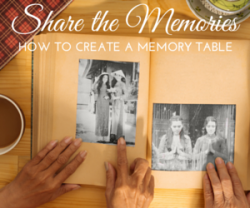How to Create a Memory Table
As you plan a funeral and prepare for the memorial service, you may want to gather items for display on a memory table. Many funeral homes ask you to provide mementos and pictures of the deceased as a way to create a visual representation of a life well-lived. In addition to the slideshows or enlarged photos for display you already have planned, these items can be nicely arranged near the guestbook or entrance.
Memory tables have the advantage of being personalized to each unique individual. Because you choose items that were precious to the deceased or that signify an important moment in his or her life, no two memory tables are ever the same. You also have the flexibility to set it up any way you want.
- Choose Items and/or a Theme: It can be difficult to wade through an entire lifetime’s worth of belongings to find the perfect table display. Choose a theme or one important item to be the focal point, and build from there. Sports, military service, a progression of life over the years, family, a special locket, a prestigious award…all these things can provide a place for you to start.
- Decide on Table Size: A small table can work just as well as a large one. Ask the funeral home how much space you’ll have to set up, and choose your items accordingly. Most people will want to touch things and take the time to examine them closely, so you’ll want space to spread them out.
- Label Items: Oftentimes, personal memos and framed photos speak for themselves, but this may not always be the case. Label items or write short stories explaining the significance of each one. People will appreciate being able to understand the significance of the items you’ve chosen to display.
- Personalize the Experience: The reason that pictures or a favorite hat make such good items on a memory table is because they are very personal items belonging to the deceased. Try to get as many personal items in there as you can—things with handwriting or a beloved book that has been marked with notes in the margins tend to work really well.
- Get Creative: There’s no limit to what you can display, as long as you’re being respectful of the deceased. Blow up a map and pinpoint all the deceased’s world travels. Frame a picture with a large mat that has room for the guests to sign their names. Provide pen and paper for guests to jot down their favorite memories to be put in a scrapbook later.
- Take a Picture: Be sure and take a picture of your memory table before the funeral begins. Chances are items will get moved around, and you’ll want a reminder of your hard work and display before everyone arrives.
Most memorial tables are only on display during a funeral service, and the items are then taken care of (or divided) afterward. However, these can also be set up in your private home or put in a glass case for display somewhere public—especially if the deceased contributed to your community or history in a significant way.



